Only Clerics should move like Bishops.
5th Edition Dungeons & Dragons embraces non-Euclidean movement. That means it’s agnostic as to lateral vs. diagonal movements in gridded combat. Such a system sacrifices a little realism for the benefit of simplification, with no impact to balance.
Some DMs and players don’t like to sacrifice realism. Thankfully, I’m here to make things easier on those who want to make it harder on themselves.
History of Diagonal Movement in D&D
In ages past, diagonal movement in D&D followed the 1-2-1-2 Rule. Under this rule, your first diagonal movement only cost you one space (5 feet). However, your second diagonal movement would cost you two spaces (10 feet). Your third would cost one space (5 feet) again, then your fourth would cost two spaces (10 feet), ad nauseam.
4th Edition dispensed with this difference, creating the 1:1 Rule. Under this rule, lateral and diagonal movement both take one space (5 feet). This change may have been to avoid unnecessary complication in a system that was already very move-intensive.
5th Edition maintained this new tradition, perhaps for different reasons, in congruence with its theme of simplification. One great thing about 5th Edition D&D is its flexibility to adapt and incorporate different systems at the table. With that in mind, let’s try something out.
True Move Distance
For those who like their fantasy strongly grounded in reality, I introduce:
Euclidean Move Distance Visualizer
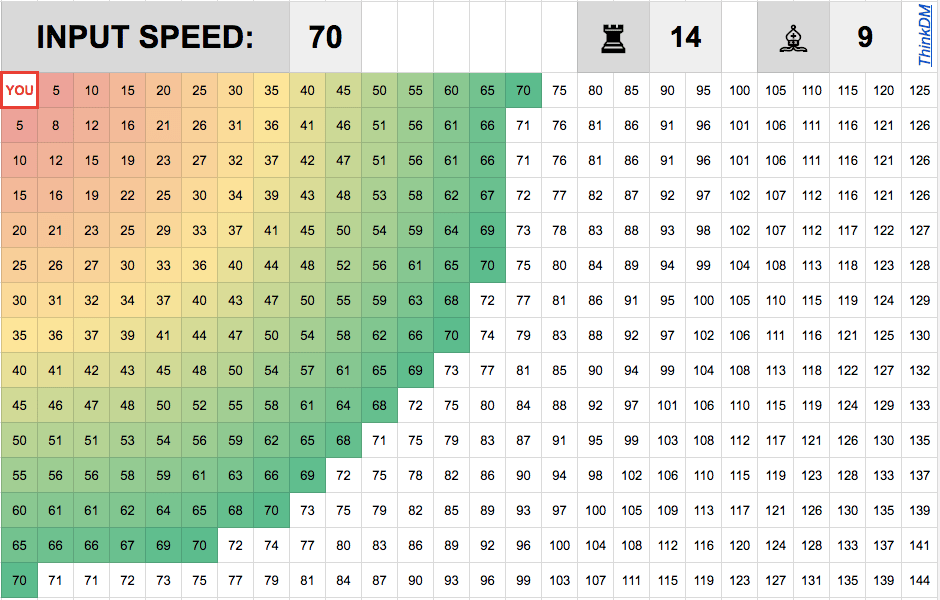
Just input your speed and the calculator will show you how many spaces you can move horizontally (♜) and diagonally (♝). It will also plat out the distance you can move on the visualizer. Each square is a space on the grid. The numbers represent the true (Euclidean) distance from your position on the grid.
You can use the visualizer during your session, or to create templates to drop directly on your play space. If you tinker with it with a little bit, you’ll begin to recognize the patterns as speed increases. Internalizing these patterns is possible, but not an elegant solution to Euclidean movement rules.
What you may notice from tinkering with the visualizer is that the 1-2-1-2 Rule was not entirely accurate. It was a compromise between fantasy and reality. It seems the designers realized in hindsight that the compromise wasn’t worth making.
It would only be worth revisiting such a system if it could accurately represent Euclidean movement while keeping the rules manageable.
Three-Rule Implementation
For all the basic classes, you can get by without using the calculator or stenciling templates. Following these three rules will allow you to preserve Euclidean move distance for all creatures with a move speed between 25 feet and 40 feet:
♜. The Rook. You can move your full move distance laterally (up, down, left, or right):
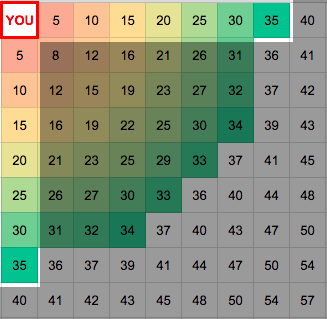
♞. The Knight. You can move your full move distance minus one space for the three rows/columns next to a lateral movement:
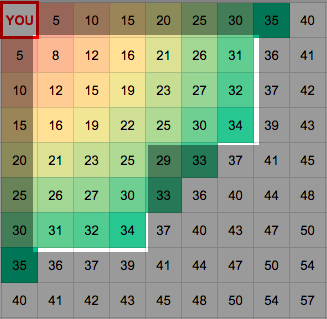
♝. The Bishop. Subtract one more space for each row/column past three:
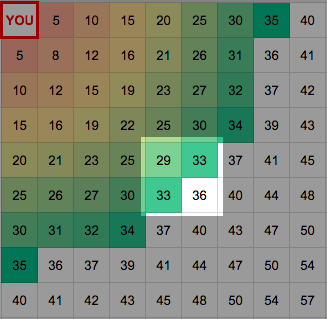
This Three-Rule Implementation breaks down a little bit beyond these movement ranges. At 15 feet and 20 feet, the Knight range is 2 rows/columns before the Bishop takes over. At 45 feet, the Knight range becomes 4 rows/columns, and further expands at higher speeds. As a result, this system will be harder to implement if your party is full of Half-Elf (base 30 speed) Barbarians (Fast Movement), Monks (Unarmored Movement), or spellcasters (Expeditious Retreat, Windwalk, Longstrider, Haste) who took the Mobile feat. For such cases, the visualizer goes up to 125 speed, or you can chop together shorter distances.
Charts for Standard Movements
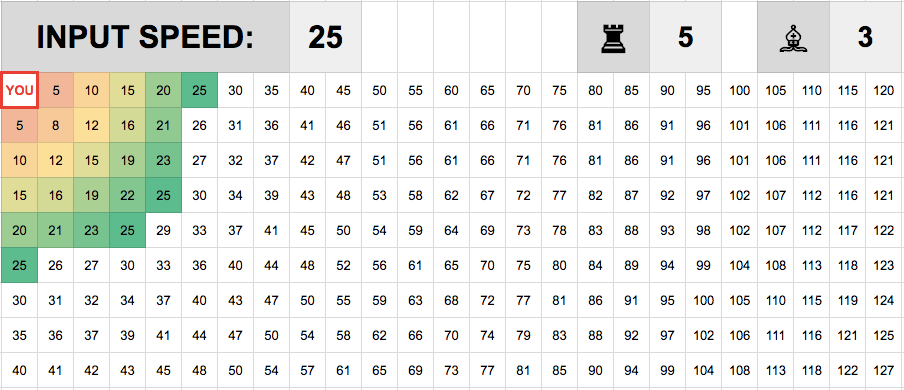
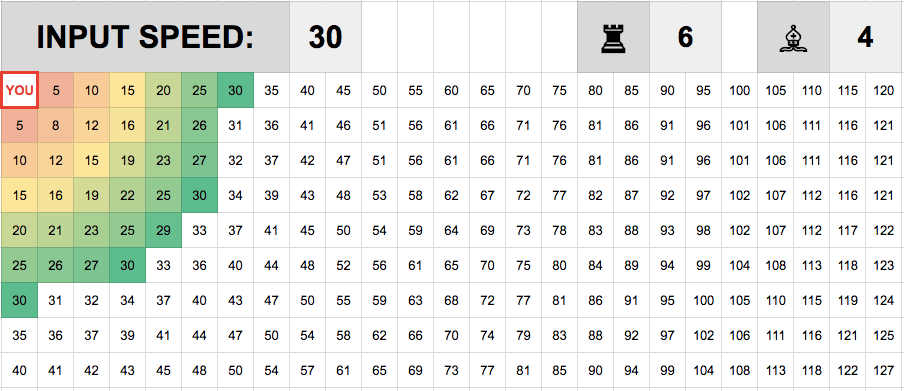
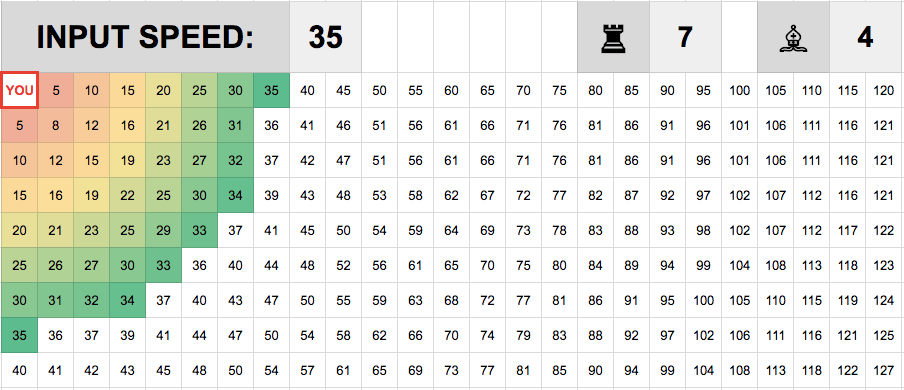
Now you can find your place in the multiverse.
Ive read almost everything youve written now, and this is the first time i actually think youre off. Moving 7 spaces 1,2 gets you to the exact location with just 1 rule. Moving 14 spaces, gets you within 1 space of your correct location. 1 rule, no charts or templates, everyone sacrifices maybe 1 space. 1,1 loses 2 across 7 spaces, or 5 across 14. But since everyone follows the same rule, im not convinced more realism has a practical impact either way. Maybe it does by interacting with a players intuition. At a glace, diagonal spaces seem farther away, until you count them.
LikeLike
Glad you enjoy the blog! I’ve got to admit: this was more of an intellectual curiosity for anyone who wants to use euclidean move distances. As a result of the exercise, I’ve got a solid understanding of how to run euclidean combat. Though, I wouldn’t expect my players to, which makes it harder to run at the table. For tables who want a more realistic combat experience on a grid, this alternate rule is an option. I wouldn’t recommend it for most folks.
LikeLike